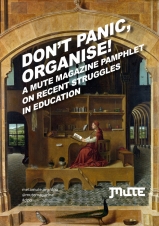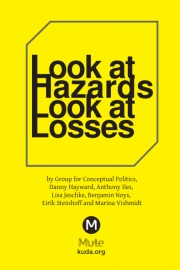A Bridge Collapses
Back to the bridge. Apparently the New York Times is pissed off about last week's Minneapolis bridge collapse, and the steam pipe that blew up round the corner from their offices too. Turns out that bridges are the *least* decayed part of the US's dodgy inventory.
You can say that the level of fault detection is now paranoiacally over-developed, and that really everything aint so bad, but I'm with Amadeo Bordiga on this; only the enormous retardedness of the last 30 years or more of capitalism, and its inherent insanities since inception, make 'random' disasters of this order a 'necessary' part of life. Technologically we are beyond this, but capitalist social relations holds us back.
Bataillean economists may look forward to the next 30 years as a bonanza of auto-destructive bridges, etc crowned by 'actual death genocide' (as an intellectually non-reproduced art student put it in one of his essays) in the form of WW3 etc at the end of it, but i'd rather live in a world where expenditures without reserve were collectively decided rather than imposed, like a falling bridge, from above.
Marx uses the metaphor of the building which only reveals its structure after it has collapsed (a materialist owl of Minerva?) as an analogue for the ineluctable if ('normally') invisible force of the law of value; all around us signs of this law's persistence are blossoming. If people learn to read these aright, they might begin to think about imposing a collapse from below. Brute material augurs of the crisis currently being registered - in terms of exchange value - in the jagged graphs of the credit markets, these pieces of the Real can either knock us down or wake us up to the insanity of a material world dominated by the drive to accumulate capital.
The other option, howver, is that they spark a neo-productivist drive for reconstruction and repair; apart from all the other problems with this, I suspect it would suffer from the deficiency of being entirely virtual - i.e. can the USA really afford to rebuild itself at this stage? Even with it's omnivorous looting of the rest of the planet's resources and peoples it wasn't able (or rather did not wish) to save New Orleans. And is US finance capital showing any signs of being persuaded to take a cut in the name of reproducing underlying material necessaries? Into what would it profitably pour its profits if not the construction of further debt pyramids? Chinese manufacturing, perhaps?
At the moment the frantic drive to sustain - or even just make - a reasonable return on investments in ultimately junk assets is intensifying the US's race to the bottom. Hence the next Rooseveltian 'New Deal', but not perhaps the next Depression, seems unlikely to be more than a screen for a last bout of imperial looting.
Bhttp://www.nytimes.com/2007/08/05/opinion/05sun1.h...
August 5, 2007EditorialA Bridge Collapses
The nation’s physical foundations seem to be crumbling beneath us. Last week, a 40-year-old interstate highway bridge collapsed in Minneapolis, plunging rush-hour traffic into the Mississippi River 60 feet below. Two weeks earlier, an 83-year-old steam pipe under the streets of Manhattan exploded in a volcano-like blast, showering asbestos-laden debris. And two years before that, substandard levees gave way in New Orleans, opening the way for the floodwaters of Hurricane Katrina.
These are some of the most dramatic signs of the nation’s failure to maintain and enhance its aging physical structures at a time when demands on roads, transit systems, sewage treatment plants and other vital facilities are rising. In the event of a catastrophic failure, many lives can be lost. But even the slower deterioration undermines our quality of life and retards economic growth. Traffic jams waste gasoline, pollute the air and exhaust drivers’ patience. Disabled trains and subways strand commuters. Gridlocked airports disrupt travel plans. And power failures plunge millions into darkness.
At a time of ballooning deficits, and in the midst of a hugely expensive war, most politicians will be tempted by the quick and inexpensive fix. But that is exactly how the country got into this problem. How large a challenge the country is facing can be seen in a report by the American Society of Civil Engineers, grading the nation’s infrastructure. The latest report, issued in 2005, assigned a cumulative grade of D, down from D+ four years earlier. Near-failing grades of D- applied to drinking water, sewage treatment and navigable waterways. The highest grade, C+, went for landfills and the recycling of solid waste.
In between were unsafe dams, whose number was rising faster than they could be repaired; overstressed power lines, whose maintenance budgets had decreased for a decade; public parks and beaches that were falling into disrepair; and deteriorating schools that seemed unlikely to accommodate rising enrollments or allow smaller classes.
Bridges actually scored relatively well, earning a straight C, mostly because the percentage of the nation’s 590,000 bridges that were rated structurally deficient or functionally obsolete had dropped slightly, to 27 percent. The deficiency rating does not mean a bridge is in danger of collapse, but it does reflect the need for repairs, close monitoring and perhaps weight restrictions.
No one yet knows what caused the Minneapolis bridge, one of those deemed structurally deficient, to fall apart. Theories include undetected cracks or metal fatigue, vibrations from a resurfacing project on the roadway, or possibly soil erosion around the underwater supports.
The design of the structure was almost certainly an element. The 1,900-foot span lacked much redundancy for its critical supports, which could allow a single failure of a crucial structural part to bring down the whole edifice. The notion that critical parts ought to have backup systems seems so basic to current engineering practice that it is shocking to learn that some 756 bridges of similar design around the country also lack redundancy. They will need to be inspected and monitored with great care.
Unfortunately, the adequacy of current inspections is also in question. It is disturbing that the pipe that burst in Manhattan had just been inspected and declared sound by a utility crew, that the levees in New Orleans had been regularly inspected by the Army Corps of Engineers, and that the Minneapolis bridge had been inspected annually.
In these and other failures it will be important to establish whether the inspectors failed to do a diligent job or whether the real problem is that inspections are inherently limited in what they can detect. Perhaps inspectors need to be given much better sensing equipment to detect hidden flaws.
The larger problem of crumbling roads, bridges and levees and crashing electrical grids can almost always be traced to a lack of investment. When budgets are tight, elected officials find it convenient to cut back on maintenance and leave some future administration to deal with the consequences. When Congress appropriates money for public works, the legislators typically prefer shiny new projects thatwill enhance their reputations, not mere maintenance on a bridge named after someone else. The federal government has particularly lagged in paying forinfrastructure projects, leaving state and local governments to assume the dominant role.
Congress is now scrambling to provide extra money to help Minnesota replace its stricken bridge and is planning hearings on broader infrastructure needs. Onesensible bill that ought to be quickly passed would set up a commission to assess the state of the nation’s infrastructure, set priorities, and recommend financing approaches. Another bill is proposing a new national bank to leverage both public and private investment for repair and new construction projects.
Each time there is one of these tragedies, politicians briefly declaim the need for a major and sustained investment in the nation’s aging infrastructure. But that enthusiasm quickly flags. The collapse of Minneapolis’s Bridge No. 9340 is a reminder that such long-postponed investments can no longer be neglected.
Mute Books Orders
For Mute Books distribution contact Anagram Books
contact@anagrambooks.com
For online purchases visit anagrambooks.com






